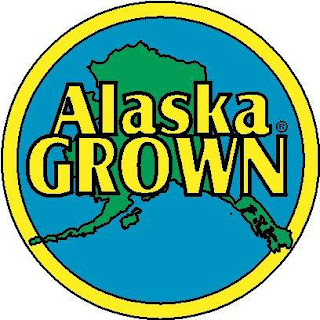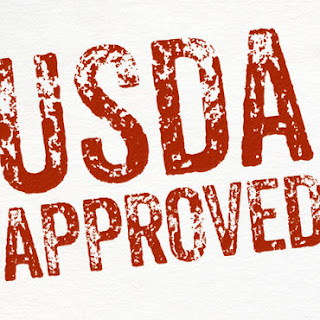But what, exactly, does it mean?
Fierce defenders, those producers who bust butt to grow or raise food here in state, believe it means wholly grown or raised here, period. Basically from birth to butcher, germination to harvest, no wiggle room allowed.
Other folks? Well, not so much. Even Dear Director (of the DOA) has waffled on what qualifies as Alaska Grown.
When it comes to branding and marketing, AlaskaGrown has a certain panache, a certain expectation that surrounds the concept and the bright yellow, blue and green logo. Proudly worn by those born here, and sported by fans and tourists who visit, it is an unmistakable symbol of Alaska agriculture.
That marketing gets marginalized and blurred, when this happens:
(We'll take four dozen of the Alaska hardy pineapple plants, please!)
Or the signage in your local grocery store does not reflect what's actually on the shelf, or the produce cannot be found at all, or you're wondering at the very large images of your competitor, proudly beaming down from on high...and fuming about how they were chosen, and you (and your farm) were not.
Or worse...the packaging can be misleading, as well as the terms used to describe the package contents. In theory, to qualify for AlaskaGrown, an animal must spend at least 51% of its life here in Alaska. This applies to vegetables imported as seedlings as well.
A large number of food producers (of all types) don't bother with the AlaskaGrown designation. It is a relatively inexpensive branding to acquire, but the programs' history is sketchy and memories are long in Alaska agriculture. Others prefer to create their own brands and labels for marketing, not replying on the common denominator concept for local advertising and promotions. Alaskan producers are just as independent as any other group here, and some want to build their own identity, without the checkered auspices that the logo represents.
Yet an incident whereby the Director of the DOA, acquiesced that imported vegetables could be sold as AlaskaGrown, if it spent any time at all in Alaska dirt....leaves residents and consumers alike wondering just how AlaskaGrown their purchases truly are. As usual, the DOA spreads more confusion and distrust with the following:
Not one to miss an opportunity to re-plow harrowed ground, the DOA has jumped on a related platform they're calling a "Livestock Certification/Quality Assurance Program" There are already national programs, so it can safely be presumed that the DOA has sniffed out grant money/federal funds to reinvent the wheel for Alaskan farmers and ranchers. Since more programs=more money=more staff=more important DOA, you can be sure that this will be created and launched regardless of need or impact. Are Alaskan cattle and hog producers going to jump happily into this new program that the DOA will provide for their assistance? Perhaps a few, but most are too busy building their businesses, fighting bureaucracy, and struggling to cover expenses, to pay attention to whatever it is they're blathering about in Palmer.
When it comes to "truth in advertising", Alaska is a wide open field of possibilities. The AlaskaGrown program, for all its purported benefits, is not necessary for marketing. Those that would deliberately mislead the consumer, are easily caught out for their actions, thanks in no small part to the tiny population and the rise in social media. That there is no standard for cattle and hogs processed here should come as no surprise to anyone. Thankfully, Alaska remains small enough that if you have questions, you can always just call the farm or ranch yourself, and ask.






